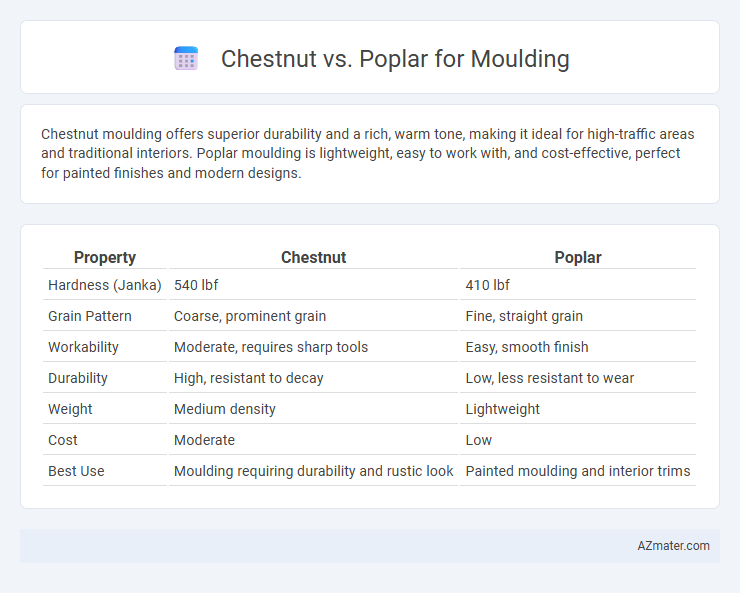Chestnut moulding offers superior durability and a rich, warm tone, making it ideal for high-traffic areas and traditional interiors. Poplar moulding is lightweight, easy to work with, and cost-effective, perfect for painted finishes and modern designs.
Table of Comparison
| Property | Chestnut | Poplar |
|---|---|---|
| Hardness (Janka) | 540 lbf | 410 lbf |
| Grain Pattern | Coarse, prominent grain | Fine, straight grain |
| Workability | Moderate, requires sharp tools | Easy, smooth finish |
| Durability | High, resistant to decay | Low, less resistant to wear |
| Weight | Medium density | Lightweight |
| Cost | Moderate | Low |
| Best Use | Moulding requiring durability and rustic look | Painted moulding and interior trims |
Introduction to Chestnut and Poplar for Moulding
Chestnut and poplar are popular wood choices for moulding due to their distinct characteristics. Chestnut offers a rich, warm tone with natural durability, making it ideal for decorative and structural moulding in traditional and rustic interiors. Poplar, known for its smooth texture and ease of painting, provides a cost-effective option with stable performance and minimal warping for modern and painted moulding applications.
Chestnut Wood Characteristics
Chestnut wood offers exceptional durability and natural resistance to decay and insect damage, making it a superior choice for moulding compared to poplar. Its rich, warm tones and distinct grain patterns provide an attractive, rustic appearance ideal for traditional and high-end interior designs. Chestnut's hardness and dimensional stability ensure long-lasting, warp-resistant moulding that maintains its shape and finish over time.
Poplar Wood Characteristics
Poplar wood is favored for moulding due to its lightweight, affordability, and ease of machining, offering smooth finishes that take paint well, making it ideal for intricate profiles. Its moderate hardness provides durability without excessive wear on tools, while its straight grain minimizes warping and splitting. Poplar's pale color allows for versatile staining, though it is commonly painted to achieve consistent, clean aesthetics in interior trim work.
Durability: Chestnut vs Poplar
Chestnut offers superior durability compared to poplar, featuring a harder grain that resists dents and scratches, making it ideal for high-traffic areas in moulding applications. Poplar is softer and more prone to wear, which may require more frequent maintenance or replacement. For long-lasting performance and resistance to damage, chestnut is the preferred choice over poplar.
Workability and Machining Comparison
Chestnut offers superior workability compared to poplar due to its fine, straight grain and consistent texture, making it easier to shape and sand smoothly. Poplar is generally softer and less dense, which allows for faster machining but can result in a higher risk of dents and tear-out when cutting intricate profiles. Choosing chestnut for moulding provides a balance of durability and precision, whereas poplar suits projects needing quick shaping with moderate finishing requirements.
Aesthetic Differences: Color and Grain
Chestnut moulding features warm, rich tones ranging from golden brown to deep reddish hues, with pronounced, coarse grain patterns that add rustic charm and character to interior spaces. Poplar moulding offers a more uniform, lighter color palette, typically creamy white to pale green, with a smoother, straighter grain that provides a clean, modern aesthetic suitable for painted finishes. The distinct color depth and textured grain of chestnut create a visually striking contrast compared to poplar's subtle, understated appearance.
Cost and Availability
Chestnut moulding typically costs more than poplar due to its durability and rich, distinct grain pattern often favored for premium woodworking projects. Poplar is widely available and generally more affordable, making it a popular choice for budget-conscious applications and easy sourcing in most lumber markets. The cost-effectiveness and accessibility of poplar make it ideal for large-scale moulding projects, while chestnut is chosen for high-end finishes where appearance and longevity justify the higher price.
Environmental Impact and Sustainability
Chestnut moulding is often favored for its sustainability due to its abundance and rapid growth, resulting in a lower environmental footprint compared to poplar. Poplar, while also renewable, typically requires more chemical treatments and energy-intensive processes during manufacturing, increasing its environmental impact. Choosing chestnut supports sustainable forestry practices and reduces carbon emissions linked to moulding production.
Popular Applications in Moulding
Chestnut and Poplar are both popular choices for moulding due to their unique properties and aesthetics. Chestnut moulding is favored for its rich grain and durability, making it ideal for decorative trim in historic restorations and upscale interiors. Poplar moulding offers a smooth surface and easy stainability, making it popular for painted mouldings in modern homes and commercial spaces.
Choosing the Right Wood for Your Project
Chestnut offers a durable, coarse-grained texture with natural resistance to decay, making it ideal for traditional and rustic moulding projects requiring longevity. Poplar, known for its smooth grain and ease of painting, provides a cost-effective, lightweight option suitable for interior moulding that demands a clean, uniform finish. Selecting between chestnut and poplar depends on the desired aesthetic, durability needs, and whether the moulding will be stained or painted.

Infographic: Chestnut vs Poplar for Moulding
 azmater.com
azmater.com